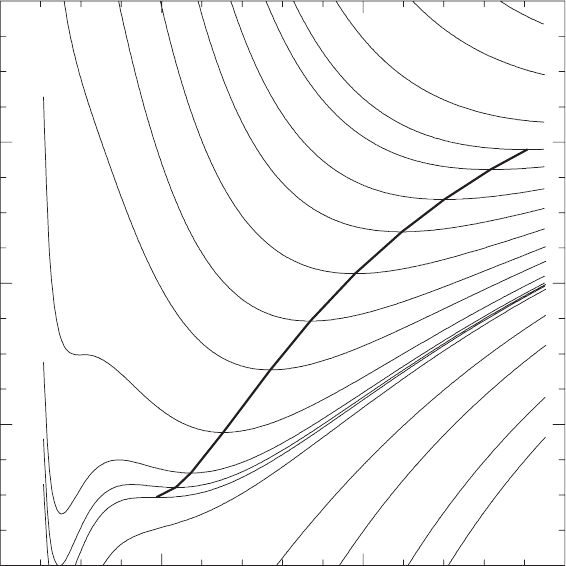Baumgarte T., Shapiro S. Numerical Relativity. Solving Einstein’s Equations on the Computer
Подождите немного. Документ загружается.


12.1 Binary inspiral: overview 401
the previous minimum in the J = constant energy curves; for smaller values of J these
curves no longer have extrema. This behavior means that circular orbits can only exist for
sufficiently large values of J .
As a result of this correction, the equilibrium energy (12.27), which connects the extrema
in the J = constant energy curves and is represented by the dashed line in Figure 12.2,
now exhibits a turning point at
r
ISCO
= 6M, (12.28)
at which point equation (12.13) is satisfied. Beyond this turning point the extrema are
minima and thus represent stable circular orbits, while inside they are maxima and represent
unstable circular orbits. The turning point in the equilibrium energy therefore represents
an innermost stable circular orbit, or ISCO for short. Binary companions on quasicircular
inspiral trajectories start accelerating radially inward, plunging toward each other, after
they reach the ISCO. This dynamical transition from the inspiral phase to the plunge
and merger phase will induce a corresponding transition in the gravitational wave signal,
yielding an observable diagnostic of the transition.
For a point particle orbiting a Schwarzschild black hole, from which we constructed
the correction term (12.26), the location of the ISCO at r
ISCO
= 6M refers to the areal
radius of the orbit. It is more useful to express the critical binary separation in terms of
an invariant, like the orbital angular frequency
orb
measured by a distant observer. For a
point particle orbiting a Schwarzschild black hole we have M
ISCO
= 1/6
3/2
≈ 0.0680.
In Section 12.4 we will find similar values for binary black holes.
Exercise 12.4 Consider the orbit of a test-particle m
test
around a Schwarzschild
black hole M. The exact relativistic analog of equation (12.8) in this case is
7
˜
E
2
=
dr
dτ
2
+ V (r), (12.29)
where
V (r ) ≡
1 −
2M
r
1 +
˜
J
2
r
2
(12.30)
is the “effective potential”,
˜
E = E/m
test
,
˜
J = J/m
test
, r is the areal radius, and τ is
proper time.
(a) Circular orbits occur when dr/dτ = 0and∂ V /∂r |
J
= 0 = ∂
˜
E/∂r |
J
,whichis
the relativistic counterpart of equation (12.9). Show that such orbits satisfy
˜
E
2
eq
=
(r − 2M)
2
r(r − 3M)
, (12.31)
˜
J
2
eq
=
Mr
2
r − 3M
(12.32)
as quoted in Chapter 1.2.
7
See, e.g., Shapiro and Teukolsky (1983), Chapter 12.3.

402 Chapter 12 Binary black hole initial data
(b) The transition from orbital stability to instability occurs when ∂
2
V/∂r
2
|
J
= 0,
which gives r
ISCO
= 6M. Show that this transition occurs when
∂
˜
E
eq
/∂r = 0 = ∂
˜
J
eq
/∂r, (12.33)
which is the counterpart of equation (12.13). Thus the point of marginal stability
corresponds to a simultaneous turning-point in the equilibrium energy and angular
momentum curves. The existence of simultaneous turning-points in the two curves
is a general result that follows from equation (12.14) in Newtonian gravitation and
equation (12.112) in general relativity.
(c) Apply equation (12.14), together with equations (12.31)and(12.32), to show
that
orb
is again given by equation (12.12) in these coordinates.
We emphasize, however, that for binaries with similar masses, q ≈ 1, the transition from
inspiral to plunge is not sharp. This can be seen from equation (12.24), which shows that
τ
orbit
/P approaches unity close to the ISCO if q ≈ 1. For such a binary, the radial inspiral
is already appreciable over an orbital period as it reaches the ISCO, so that the transition
from inspiral to plunge and merger is gradual rather than sharp. Stated differently, the
deviations from circular orbit are already large as binaries with companions of comparable
mass approach our so-called ISCO. In Chapter 13 we will see that dynamical simulations
of binary black hole merger indeed verify this expectation. The notion of the ISCO is
nevertheless a useful concept for the comparison and characterization of initial data sets.
It is useful to note that any attractive interaction potential that falls off more steeply than
1/r
2
results in an ISCO.
Exercise 12.5 (a) Show that any attractive interaction potential energy of the form
−λa
n+1
/r
n
,whereλ>0 is a dimensionless constant and a > 0 carries dimensions
of length, leads to a positive contribution to the equilibrium energy E
eq
provided
that n > 2.
(b) Find the minimum of E
eq
to locate the ISCO at
r
n−1
ISCO
= λn(n − 2)
a
n+1
Mµ
, (12.34)
which is again positive if n > 2.
The ISCO is therefore not only a relativistic phenomenon, but can also arise in Newtonian
gravitation. For example, two fluid stars treated not as point masses but as hydrodynamic
equilibria of finite size, experience a tidal interaction.
8
For irrotational, identical stars, for
example, we can model these tidal effects by including a tidal interaction term
E
tidal
=−λ
µMR
5
r
6
. (12.35)
Here R is the stellar radius, and the dimensionless parameter λ depends on the equation of
state. For an incompressible fluid λ = 3/2, and from equation (12.34) we find the ISCO is
8
See Lai et al. (1993b, 1994b) and references therein for a semi-analytic analysis and models.
12.2 The conformal transverse-traceless approach 403
located at
r
ISCO
= (24λ)
1/5
R ≈ 2.05R, (12.36)
implying that such a binary would reach the ISCO just before the two stars touch. We
have plotted this result in Figure 12.2 for identical stars of compaction m/R = 0.2, where
m = M/2 is the mass of the individual stars; we also show the combined effects of
relativistic corrections and tidal interactions in determining the ISCO. For compressible
stars λ is smaller than 3/2, so that in Newtonian gravitation these stars would merge before
they could encounter any ISCO. However, in general relativity, for identical irrotational
companions constructed with a moderately stiff equation of state, the entire equilibrium
sequence actually terminates at a finite separation prior to merger, at which point the stellar
density profiles form a cusp (see Chapter 15.3). Orbital decay beyond this point will then
trigger some tidal disruption prior to eventual merger (see Chapter 16).
After reaching the ISCO, the binary companions plunge and merge on an orbital time
scale. Depending on the nature and masses of the compact companions, their coalescence
leads to the formation of a merged object, or remnant, that may either be a rotating neutron
star or a black hole. During the final ringdown phase of the binary evolution this remnant
settles down into an equilibrium state. In the case of a hypermassive neutron star, secular
effects (viscosity or magnetic fields) can lead later to delayed collapse to a black hole (see
Chapters 14 and 16.)
During the inspiral phase, up to reasonably small binary separations, the binary can
be modeled very accurately by post-Newtonian expansions (see Appendix D). The ring-
down phase can be described very well by strong-field perturbative techniques. Numerical
relativity simulations are needed to connect these two regimes, beginning with the late
inspiral phase, and continuing through the dynamical plunge and merger phase. Numerical
relativity is also required to treat delayed collapse. Not surprisingly, considerable effort in
numerical relativity has focused on compact binaries in close quasicircular orbits. In the
rest of this chapter we will construct initial data for binary black holes in such orbits.
12.2 The conformal transverse-traceless approach: Bowen–York
12.2.1 Solving the momentum constraint
In the transverse-traceless approach we assume both conformal flatness, so that ¯γ
ij
= η
ij
,
and maximal slicing, so that K = 0. The momentum constraint (12.4) then reduces to
¯
D
j
¯
A
ij
= 0, (12.37)
where
¯
D
j
is now a flat-space covariant derivative. In Cartesian coordinates this operator
reduces to the partial derivative ∂
j
. Our assumptions have simplified the momentum
constraint to the point where the decomposition of
¯
A
ij
into a transverse and a longitudinal
part (see equation 3.48) is somewhat pointless, since both of them now have vanishing

404 Chapter 12 Binary black hole initial data
divergence. It is nevertheless useful to keep this decomposition in mind, since it makes
the counting of freely specifiable variables more transparent. In particular we will choose
¯
A
ij
TT
= 0, which amounts to making two arbitrary choices for its two independent variables.
We still have to find solutions
¯
A
ij
L
, but as we have seen in Chapter 3.2 we can construct
these analytically given our assumptions of conformal flatness and maximal slicing. This,
in fact, is the essence of this so-called Bowen–York approach: we can solve the momentum
constraint analytically, leaving only the Hamiltonian constraint to be solved numerically.
In Chapter 3.2 we found two such analytical black hole solutions to (12.37); one that
carries a linear momentum P
i
,
¯
A
ij
P
=
3
2r
2
P
i
n
j
+ P
j
n
i
− (η
ij
− n
i
n
j
)n
k
P
k
(12.38)
(see equation 3.80), and one that carries an angular momentum (spin) S
i
,
¯
A
ij
S
=
6
r
3
n
(i
j)kl
S
k
n
l
(12.39)
(see equation 3.66). Here we are assuming Cartesian coordinates, r =
x
2
+ y
2
+ z
2
is
the coordinate distance to the center of the black hole (which is located at the origin), and
n
i
= x
i
/r is the normal vector pointing away from the black hole’s center. In exercise 3.32
we evaluated the surface integral (3.195)
P
i
=
1
8π
(
∞
K
ij
dS
j
(12.40)
to show that the linear momentum associated with equation (12.38) is indeed P
i
,andin
exercise 3.29 we computed
J
i
=
ijk
8π
(
∞
x
j
K
kl
dS
l
(12.41)
to verify that the angular momentum associated with equation (12.39)isS
i
.
To allow for a black hole located at a point C
i
we introduce a subscript (or occasionally
superscript) C. We then have
¯
A
ij
CP
=
3
2r
2
C
P
i
n
j
C
+ P
j
n
i
C
− (η
ij
− n
i
C
n
j
C
)n
k
C
P
k
, (12.42)
and
¯
A
ij
CS
=
6
r
3
C
n
(i
C
j)kl
S
k
n
C
l
, (12.43)
where r
C
=||x
i
− C
i
|| is the coordinate distance to the center of the black hole located at
x
i
= C
i
,andn
i
= (x
i
− C
i
)/r
C
is the normal vector.

12.2 The conformal transverse-traceless approach 405
Given that the momentum constraint (12.37) is linear, we can construct a binary black
hole solution by superposition of single solutions
¯
A
ij
=
¯
A
ij
C
1
P
1
+
¯
A
ij
C
1
S
1
+
¯
A
ij
C
2
P
2
+
¯
A
ij
C
2
S
2
. (12.44)
This completes an analytic solution of the momentum constraint describing two black
holes with arbitrary momenta and spins.
Exercise 12.6 Show that
9
P = P
1
+ P
2
(12.45)
is the total linear momentum of the solution (12.44)and
J = C
1
× P
1
+ C
2
× P
2
+ S
1
+ S
2
(12.46)
its total angular momentum about the origin of the coordinate system.
For a binary system, S
1
and S
2
can be associated with the spin of the individual black
holes only in the limit of infinite binary separation, but we nevertheless take the liberty to
define the orbital angular momentum L as
L ≡ J − S
1
− S
2
. (12.47)
12.2.2 Solving the Hamiltonian constraint
With a solution to the momentum constraint at hand we can now proceed to solve the
Hamiltonian constraint (12.3). Under the assumptions of conformal flatness and maximal
slicing, this equation reduces to
¯
D
2
ψ =−
1
8
ψ
−7
¯
A
ij
¯
A
ij
. (12.48)
We have reduced the construction of binary black hole initial data to solving a single
nonlinear elliptic equation. On the right hand side, the term
¯
A
ij
¯
A
ij
can be computed
analytically from (12.44). Unfortunately this term diverges at the black holes’ centers C
i
.
Dealing with this singularity requires some extra care.
Two different approaches have been adopted in the literature to solve this problem; they
differ in the topology of the resulting solution. Recall our discussion in Chapter 3.1,which
demonstrated that initial data sets representing multiple black holes are not unique. As a
starting point, we can look for generalizations of the time-symmetric solution
ψ = 1 +
M
1
r
C
1
+
M
2
r
C
2
, (12.49)
9
To represent the momenta P
i
and spins S
i
of these solutions it is convenient to use bold-face notation P and S instead
of index notation.

406 Chapter 12 Binary black hole initial data
which solves equation (12.48)for
¯
A
ij
= 0 (i.e., Laplace’s equation). This solution repre-
sents the three-sheeted topology sketched in Figure 3.2. In this topology each black hole
generates an Einstein–Rosen bridge to its own asymptotically flat universe, meaning that
the solution is not symmetric across each throat. This symmetry can be recovered, how-
ever, by introducing “spherical inversion images”. This approach leads to a two-sheeted
topology, schematically represented in Figure 3.3, in which the two black holes connect
two identical asymptotically flat universes.
In the conformal imaging approach
10
a two-sheeted topology is assumed. Establishing
the isometry between the two sheets requires adding image terms to the extrinsic curvature
(12.44).
11
Once this has been done, the two sheets, representing two asymptotically flat
universes connected by two Einstein–Rosen bridges (see Figure 3.3), are exact mirror
images of each other. We therefore need to solve the Hamiltonian constraint (12.48) only
on one of these two sheets; we could always find the conformal factor on the other sheet
from the symmetry. This means that we eliminate the black hole interior containing the
black hole singularities from the computational domain and solve (12.48) only in the black
hole exterior. This is an example of black hole excision, which we will encounter many
more times.
Clearly we need a boundary condition for the conformal factor ψ on the black hole
throats, the interior of which we excise. These boundary conditions follow immediately
from the isometry that is imposed on the throats.
While the isometry of the resulting two-sheeted solutions is aesthetically appealing, the
conformal-imaging approach requires complicated image terms for the extrinsic curvature
as well as the imposition of boundary conditions on internal boundaries. The puncture
approach,
12
which leads to a three-sheeted topology, avoids both of these difficulties.
The key idea of the puncture approach is to absorb the singularities arising in the solution
to equation (12.48) in analytical terms. As we have said before, the expression (12.49)
satisfies the Hamiltonian constraint (12.48)for
¯
A
ij
= 0. We may therefore write the general
solution as equation (12.49), the homogeneous solution, plus a new term correcting for
finite
¯
A
ij
. As it turns out, this new term satisfies an equation that is regular everywhere.
We begin by writing
ψ = 1 + 1/α + u, (12.50)
where α is defined by
1
α
≡
M
1
r
C
1
+
M
2
r
C
2
. (12.51)
Here we may refer to the
M
i
as the puncture masses. It is important to realize, though, that
they can be equated to the black hole’s ADM mass or irreducible mass only in the limit of
10
Cook (1991); Cook et al. (1993); Cook (1994).
11
Kulkarni et al. (1983).
12
Beig and
´
O Murchadha (1994, 1996); Brandt and Br
¨
ugmann (1997).

12.2 The conformal transverse-traceless approach 407
infinite separation. For any finite separation these parameters have no immediate physical
meaning.
The Hamiltonian constraint now reduces to an equation for the correction term u,
¯
D
2
u =−β
(
α(1 + u) + 1
)
−7
, (12.52)
where we have used the abbreviation
β ≡
1
8
α
7
¯
A
ij
¯
A
ij
. (12.53)
Notice that α goes to zero at each one of the “punctures” C
i
. It also enters β with a
sufficiently high power to suppress the divergence in
¯
A
ij
¯
A
ij
. As a consequence the source
term in equation (12.52) is regular everywhere. We have thus eliminated the need for both
the image terms in
¯
A
ij
and for black hole excision, and can, instead, solve for u with any
standard method for nonlinear elliptic equations (see, e.g., our discussion in Chapter 6.2.2
following equation 6.54). To impose asymptotic flatness, we impose a Robin boundary
condition
∂(ru)
∂r
= 0 (12.54)
at large distances from the black holes.
Once we have found the conformal factor ψ numerically, we can compute the ADM
mass M
ADM
from equation (3.145),
M
ADM
=−
1
2π
(
∞
¯
D
i
ψd
¯
S
i
. (12.55)
Within the puncture approach we can insert the ansatz (12.50)tofind
M
ADM
=−
1
2π
(
∞
¯
D
i
1
α
d
¯
S
i
−
1
2π
¯
D
2
ud
3
x
=
M
1
+ M
2
+
1
2π
β
(
α(1 + u) + 1
)
−7
d
3
x. (12.56)
Here the volume integral in the last term extends over all space.
12.2.3 Identifying circular orbits
Up to now we have discussed how, for particular choices of black hole positions C
i
,
momenta P
i
, spins S
i
and puncture masses M
i
, we can construct a solution to the constraint
equations. We now ask how we can pick these parameters in such a way that the resulting
black holes represent a binary in circular orbit.
In a zero-momentum frame we have P = 0 and therefore
P
1
=−P
2
. (12.57)

408 Chapter 12 Binary black hole initial data
For a circular orbit these momenta must also be perpendicular to C ≡ C
1
− C
2
,
C · P
1
= 0. (12.58)
This requirement corresponds to the condition P
r
= 0inexercise12.1 and dr/dτ = 0in
exercise 12.4. We will focus on black holes that have S
i
= 0, meaning that they are not
spinning as seen in an inertial frame. We will later refer to such binaries as nonspinning.
With this choice the problem has been reduced to a 4-dimensional parameter space. The
four independent parameters may be taken to be the puncture masses
M
1
and M
2
,the
momentum P
1
=||P
1
|| and the coordinate separation C =||C||. For spinning black holes
we also have to pick the black hole spins S
i
.
13
Given these input parameters, we can construct a binary configuration by solving the
constraint equations as outlined above in Sections 12.2.1 and 12.2.2. For each configuration
we can then compute the significant physical quantities, including the total ADM mass
M
ADM
(equations 12.55 or 12.56) and the angular momentum J (equation 12.46). We then
define the binding energy E
b
as
E
b
≡ M
ADM
− m
1
− m
2
. (12.59)
Here the black hole masses m
1
and m
2
are assigned to be their irreducible masses,
14
m
i
=
(
A
i
/16π
)
1/2
, (12.60)
where
A
i
is the proper area of the event horizon of the i th black hole (see equation 7.2).
Sometimes the quantity E
b
is referred to as the effective potential (recall exercise 12.4).
Exercise 12.7 Evaluate E
b
for two black holes in circular orbit at infinite separation
and determine the sign of E
b
when the circular orbit is at finite separation.
As we discussed in Chapter 7.1, locating the black hole’s event horizon requires knowl-
edge of the entire future. We only construct data on one time slice , so clearly we cannot
compute the irreducible mass m
irr
exactly. For most of the binary inspiral, however, the
event horizons are very well approximated by the black hole’s apparent horizons (see
Chapter 7.3), and it is reasonable to compute m
irr
from these.
15
In the conformal imag-
ing approach these apparent horizons coincide with the throats on which the isometry is
imposed. The horizons are therefore at a fixed coordinate location, and their proper area
A
can be computed quite easily. In the puncture method, however, we do not know the location
13
Pfeiffer et al. (2000).
14
Some authors define the binding energy as the difference between the ADM mass and the black holes’ Kerr masses (7.3)
(e.g., Cook 1994; Pfeiffer et al. 2000). For the nonspinning black holes that we focus on here this distinction clearly
does not make any difference. In general, however, the definition (12.59) seems more natural. Since the irreducible
mass M
irr
is constant along quasistationary evolutionary sequences, the definition (12.59) leads to simultaneous turning
points in the equilibrium binding energy and the ADM mass.
15
But see Pfeiffer et al. (2000) for a discussion of rapidly spinning black holes in close binaries.

12.2 The conformal transverse-traceless approach 409
of the apparent horizons a priori, and instead we have to find them by implementing one
of the methods discussed in Chapter 7.3 before their area can be computed.
16
Lastly we compute the proper separation between the two horizons l. In practice it is
much easier to compute the proper separation along C, which is a very good approximation
to the shortest proper, or geodesic, separation (within ) for many configurations.
The condition (12.58) insures that each black hole’s momentum is perpendicular to the
separation axis, at least momentarily. Imposing this condition is not sufficient for a circular
orbit, however, since it also holds at the apocenter and pericenter of a noncircular orbit. To
guarantee a circular orbit we must impose the additional condition that the binding energy
(i.e., the effective potential) E
b
be at a stationary point along a sequence of constant angular
momentum J for fixed black hole masses m
1
and m
2
,
∂ E
b
∂l
J,m
1
,m
2
= 0. (12.61)
We already employed this condition in exercises 12.1 and 12.4 to identify circular orbits.
Once we identify the circular orbits, we can construct an equilibrium sequence of binaries
of fixed black hole masses m
1
and m
2
at different separations. As in equation (12.14)
(or equation 12.112) we can then find the binary’s orbital angular velocity
orb
at each
separation from
orb
=
∂ E
eq
∂ J
eq
m
1
,m
2
. (12.62)
To identify the ISCO, we can apply the turning-point criterion to the function E
eq
(l), as
in equations (12.13) and (12.33). Alternatively, we can apply the turning-point criterion
to the equilibrium angular momentum J
eq
(l), as noted in exercise 12.4. As pointed out in
the same exercise, applying the turning-point criterion is equivalent to finding a point of
inflection in the effective potential, ∂
2
E
b
/∂l
2
= 0.
Figure 12.3 illustrates the numerical construction of a quasiequilibrium binary consisting
of equal-mass, nonspinning black holes in circular orbit using conformal imaging and
the effective potential approach.
17
Convenient fitting formulae have been derived
18
for
the same system, using the puncture method. These handy formulae specify the puncture
masses
M,momentaP, and the quantities M
ADM
, J
ADM
and
orb
as functions of the
puncture coordinate separation C, all normalized by the total ADM mass of the binary at
infinite separation (which equals the total irreducible mass.)
We will review the resulting orbits from these numerical calculations in greater detail in
Section 12.4. But first we will discuss an alternative approach to constructing binary black
holes that probably provides a better approximation to binaries in quasiequilibrium.
16
Baumgarte (2000).
17
Cook (1994).
18
Tichy and Br
¨
ugmann (2004). Quasiequilibrium is achieved by imposing the relativistic virial relation M
K
= M
ADM
;
see Chapter 3.5 and exercise 12.9. A lapse is required for this condition and is obtained by imposing ∂ K /∂t = 0
(equation 4.12).

410 Chapter 12 Binary black hole initial data
−0.06
−0.08
−0.1
5
l
/ M
E
b
/ m
−0.04
−0.02
10 15
Figure 12.3 The binding energy E
b
/µ as a function of separation l for various values of the angular momentum
J/µM (thin lines) as obtained by the Bowen–York conformal-imaging method for an equal mass, nonspinning
black hole binary. The thick line connects a sequence of stable quasicircular orbits, which correspond to minima
of the binding energy (equation 12.61), and yields E
eq
as a function of l (“effective potential approach”). This
sequence terminates at the ISCO, identified where an E
b
curve at constant J exhibits a point of inflection. [From
Cook (1994).]
12.3 The conformal thin-sandwich approach
12.3.1 The notion of quasiequilibium
The appeal of the Bowen–York approach is that we can solve a large part of the problem
(i.e., the momentum constraints) analytically, which furnishes useful insight into how black
hole binary initial data can be constructed. However, in Section 12.4 we will find some
evidence suggesting that the resulting binary solutions may not describe astrophysically
realistic, circular-orbit, binary black holes as closely as we might like. The core of the
problem is that the Bowen–York formalism does not provide any direct means of imposing
quasiequilibrium conditions on the metric. We invoke global energy minimum arguments
